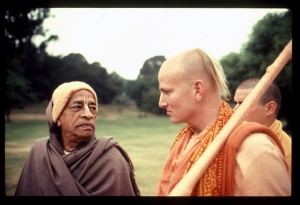CC Adi 6.79 (1975)

A.C. Bhaktivedanta Swami Prabhupada
TEXT 79
- ananta brahmāṇḍe rudra--sadāśivera aṁśa
- guṇāvatāra teṅho, sarva-deva-avataṁsa
SYNONYMS
ananta—unlimited; brahmāṇḍe—in the universes; rudra—Lord Śiva; sadāśivera aṁśa—part and parcel of Sadāśiva; guṇa-avatāra—an incarnation of a quality; teṅho—he also; sarva-deva-avataṁsa—the ornament of all the demigods.
TRANSLATION
Rudra, who is an expansion of Sadāśiva and who appears in unlimited universes, is also a guṇāvatāra [qualitative incarnation] and is the ornament of all the demigods in the endless universes.
PURPORT
There are eleven expansions of Rudra, or Lord Śiva. They are as follows: Ajaikapāt, Ahibradhna, Virūpākṣa, Raivata, Hara, Bahurūpa, Devaśreṣṭha Tryambaka, Sāvitra, Jayanta, Pināki and Aparājita. Besides these expansions there are eight forms of Rudra called earth, water, fire, air, sky, the sun, the moon and soma-yājī. Generally all these Rudras have five faces, three eyes and ten arms. Sometimes it is found that Rudra is compared to Brahmā and considered a living entity. But when Rudra is explained to be a partial expansion of the Supreme Personality of Godhead, he is compared to Śeṣa. Lord Śiva is therefore simultaneously an expansion of Lord Viṣṇu and, in his capacity for annihilating the creation, one of the living entities. As an expansion of Lord Viṣṇu he is called Hara, and he is transcendental to the material qualities, but when he is in touch with tamo-guṇa he appears contaminated by the material modes of nature. This is explained in Śrīmad-Bhāgavatam and the Brahma-saṁhitā. In Śrīmad-Bhāgavatam, Tenth Canto, it is stated that Lord Rudra is always associated with the material nature when she is in the neutral, unmanifested stage, but when the modes of material nature are agitated he associates with material nature from a distance. In the Brahma-saṁhitā the relationship between Viṣṇu and Lord Śiva is compared to that of milk and yogurt. Milk is converted into yogurt by certain additives, but although milk and yogurt have the same ingredients, they have different functions. Similarly, Lord Śiva is an expansion of Lord Viṣṇu, yet because of his taking part in the annihilation of the cosmic manifestation, he is considered to be changed, like milk converted into yogurt. In the Purāṇas it is found that Durgā appears sometimes from the heads of Brahmā and sometimes from the heads of Viṣṇu. The annihilator, Rudra, is born from Saṅkarṣaṇa and the ultimate fire to burn the whole creation. In the Vāyu Purāṇa there is a description of Sadāśiva in one of the Vaikuṇṭha planets. That Sadāśiva is a direct expansion of Lord Kṛṣṇa's form for pastimes. It is said that Sadāśiva (Lord Śambhu) is an expansion from the Sadāśiva in the Vaikuṇṭha planets (Lord Viṣṇu) and that his consort, Mahāmāyā, is an expansion of Ramādevī, or Lakṣmī. Mahāmāyā is the origin or birthplace of material nature.